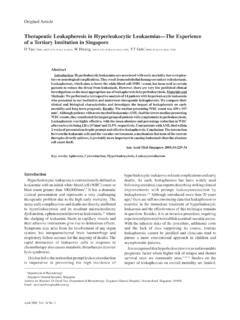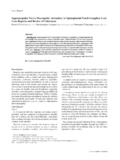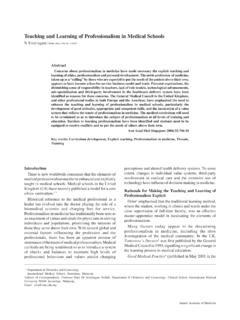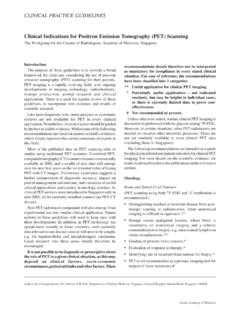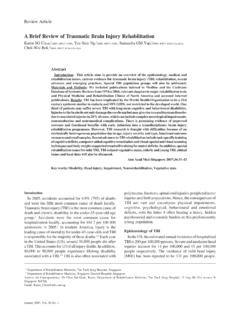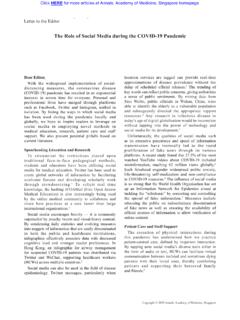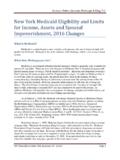Transcription of Casemix in Singapore – 5 Years On
1 660 Annals Academy of MedicineCasemix in Singapore EK Lim & CE Lee1 Healthcare Finance Division, Ministry of HealthMinistry of Health SingaporeAddress for Reprints: Dr Lim Eng Kok, Health Services Finance Branch, Healthcare Finance Division, Ministry of Health, Singapore , 16 College Road, Collegeof Medicine Building, Singapore in Singapore 5 Years OnEK Lim,1 MBChB, MSc, HSM, CE Lee,1 MBBS, M Med (PH), FAMSThe development of Casemix classification systems startedin the late 1960s when clinicians at the Yale-New HavenMedical Centre asked Professor Robert Fetter of YaleUniversity for help with the identification of aberrant casesin utilisation review. Professor Fetter argued that in orderto identify the aberrant, you had first to identify the normal,hence the advent of Casemix classification classification systems were designed to groupdiseases into clinically meaningful diagnostic clusters calledDiagnosis Related Groups (DRGs), where resource usewas similar.
2 Each DRG describes a cluster of patients withrelated diagnoses incurring similar treatment use of Casemix classification systems for fundingwas pioneered in the United States and adopted for thepublicly-financed Medicare programme in the 1980s. Sincethen, there has been a growing trend internationally towardsthe use of Casemix -adjusted payment for healthcare,especially in the past for FundingSince 1 October 1999, Casemix has been used as a tool tofund day surgery and inpatient services in public hospitalsand national centres (with the exception of WoodbridgeHospital, National Dental Centre, National Skin Centre) to the introduction of Casemix , outputs weredescribed in terms of length of stay and table of surgicalprocedures. Defining output based on length of stay washighly unsatisfactory as the resource requirements for oneday of hospitalisation can range from purely board andlodging (for those that are under observation or recuperating)to intensive care use of DRGs (which seeks to relate medical conditionsto resource use) has facilitated fairer allocation of typical cases in a single DRG can be expected to havesimilar costs for treatment, the use of DRGs allow subventionto be better correlated with resource requirements.
3 Theadjustment of DRG based subvention rates annually(based on actual cost data submitted by the hospitals) hasalso allowed the Ministry of Health to take into accountthe differing rates of medical advancement acrossdifferent DRGs. Instead of a flat rate that is appliedacross-the-board, Casemix allows us to better target theincrease to specific DRGs where additional resources funding has resulted in incentives forhealthcare providers to economise, and seek out more cost-effective treatments. Under Casemix -based funding, a fixedrate is provided for each DRG. This provides incentives forhospitals to learn where they are less efficient and toquickly take steps to improve has led to greater cost consciousness in ourpublic sector hospitals. Prior to its introduction, cost datawas only available at the service ( X-ray, ward, etc)level.
4 As Casemix required patient-level cost data in orderto compute the subvention for each DRG, it has providedthe impetus for hospitals to develop robust patient-levelcosting systems that enable them to determine the cost forthe whole episode of funding encourages hospital departmentsto adopt a collaborative approach to manage costs of entireepisodes of care ( total knee replacement) rather thanjust components of care ( surgery, rehabilitation,radiological and lab tests). This promotes the developmentof clinical pathways that seek to provide patients withseamless care across various specialities based on evidence-based practice. Casemix promotes care that is patient-centred rather than department- or way in which hospitals are organised may, however,need to be reviewed in order to provide this patient-centredapproach to care while optimising efficiency.
5 As a singlesubvention rate is provided for each DRG, hospitals candecide how to structure their services accordingly. Forexample, the hospital may decide that it may be better interms of optimising the use of expensive equipment, tocentralise the treatment of complex diseases in onedepartment while the other departments take on the breadand butter cases. The same principle could be applied fororganising services at the inter-hospital level. The way thefinancial performance for each department or speciality isreported should similarly be reviewed to encourage inter-departmental 2004, Vol. 33 No. 5661 Casemix in Singapore EK Lim & CE LeeCasemix for QualityThe key strength of Casemix is its ability to standardisethe definition of outputs of healthcare institutions. Acommon output measure is an essential building block forcost efficiency ( input/output) as well as cost effectiveness( input/outcome) studies.
6 A common output measurealso facilitates meaningful comparisons of cost, qualityand highlights differences ( outliers). Analysisof such differences can lead to more streamlined and cost-effective clinical practice. One of the key lessons from thepublication of hospital bill sizes on the Ministry of Health swebsite was that hospitals with the lowest cost per unit ofservice ( laboratory test, ward charge, etc.) need notnecessarily have the lowest cost for a particular admissionif these services are used inappropriately. For example, ahospital with the cheapest non-standard drug would still bemore expensive than another hospital that uses common output measure enables identification ofpractice variations. Review of cost data across publichospitals through utilisation management activities haveshown several areas where practices could be furtherstandardised.
7 These included the use of investigations (forexample, using specific individual tests instead of themore expensive all-inclusive panel tests),3 and the use ofexpensive drugs (through prescribing guidelines and asystem of internal checks to ensure compliance withguidelines).4It should, however, be emphasised that Casemix does nottell us what the proper practice is. In fact, the outlier maybe the hospital or department that is practicing optimally interms of quality, cost and of CasemixA key feature for Casemix classification systems is optimalnumber of groups (DRGs), not too many (which willcause some groups to have too few observations to allowconclusions to be drawn), nor too few (as overly largenumber of cases placed in the same class may conceal realdifferences between the cases).
8 However, this feature isalso the key limitation of Casemix , its effectiveness atlower levels of work on the principle of Law of Large Numbers , with sufficient number of cases, the distribution ofcases would assume a normal distribution. Thus whileDRGs work well at higher levels of aggregation ( athospital or cluster level), they are less effective at lowerlevels of dis-aggregation ( departmental or evenindividual doctor level) as the smaller number of cases atthis level means that one or more outliers can potentiallyskew the averages , if hospitals wish to examine resource utilisationat lower levels of aggregation, supplementary mechanismscan be developed. For these specific studies, additionalvariables ( patient functional status) may have to beconsidered.
9 The value of Casemix in this context is toidentify areas that need further study so that hospitals canundertake more targeted and detailed studies such as thatdescribed by Sahadevan et al5 earlier in this DRGs are often associated with funding, theywere originally developed as a tool for utilisation reviewand quality assurance. As Casemix evolves in Singapore , itis interesting to see that we are going back to basics withan increasingly important role in analysing Casemix has many strengths, it is not a perfect Casemix systems need to be enhanced to betteradjust for severity. There is also a need to extend casemixclassification systems to outpatient care as well, in line withthe move of an increasing number of inpatient treatmentsto the outpatient setting. These enhancements would needto be undertaken with care, leveraging on existing systemsto avoid increasing administrative costs.
10 Casemix systemswould also need to be supplemented with othermethodologies for more detailed conclusion, the investment in Casemix systems bypublic sector hospitals has started to bear fruit in terms offinancial savings and reducing unnecessary variations incare. This is, however, a work in progress with numerousareas for improvement. The active involvement of cliniciansis both heartening and crucial for the benefits of casemixsystems to be fully Mills R, Fetter RB, Riedel DC, Averill R. AUTOGRP: an interactivecomputer system for the analysis of health care data. Med Care1976;14 Reforming NHS Financial Flows: Introducing payment by results. UK:Department of Health, Lim YJ, Tai HY. Utilisation Management A Cluster s presented at Casemix Conference Singapore ; 2004 Mar : Ministry of Health, Toh MPHS, Tan HN.
